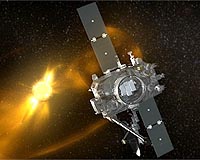 |
Pasadena CA (SPX) Apr 26, 2011 Astronomers using NASA's Galaxy Evolution Explorer may be closer to knowing why some of the most massive stellar explosions ever observed occur in the tiniest of galaxies. "It's like finding a sumo wrestler in a little 'Smart Car,'" said Don Neill, a member of NASA's Galaxy Evolution Explorer team at the California Institute of Technology in Pasadena, and lead author of a new study published in the Astrophysical Journal. "The most powerful explosions of massive stars are happening in extremely low-mass galaxies. New data are revealing that the stars that start out massive in these little galaxies stay massive until they explode, while in larger galaxies they are whittled away as they age, and are less massive when they explode," said Neill. Over the past few years, astronomers using data from the Palomar Transient Factory, a sky survey based at the ground-based Palomar Observatory near San Diego, have discovered a surprising number of exceptionally bright stellar explosions in so-called dwarf galaxies up to 1,000 times smaller than our Milky Way galaxy. Stellar explosions, called supernovae, occur when massive stars - some up to 100 times the mass of our sun - end their lives. The Palomar observations may explain a mystery first pointed out by Neil deGrasse Tyson and John Scalo when they were at the University of Austin Texas (Tyson is now the director of the Hayden Planetarium in New York, N.Y.). They noted that supernovae were occurring where there seemed to be no galaxies at all, and they even proposed that dwarf galaxies were the culprits, as the Palomar data now indicate. Now, astronomers are using ultraviolet data from the Galaxy Evolution Explorer to further examine the dwarf galaxies. Newly formed stars tend to radiate copious amounts of ultraviolet light, so the Galaxy Evolution Explorer, which has scanned much of the sky in ultraviolet light, is the ideal tool for measuring the rate of star birth in galaxies. The results show that the little galaxies are low in mass, as suspected, and have low rates of star formation. In other words, the petite galaxies are not producing that many huge stars. "Even in these little galaxies where the explosions are happening, the big guys are rare," said co-author Michael Rich of UCLA, who is a member of the mission team. In addition, the new study helps explain why massive stars in little galaxies undergo even more powerful explosions than stars of a similar heft in larger galaxies like our Milky Way. The reason is that low-mass galaxies tend to have fewer heavy atoms, such as carbon and oxygen, than their larger counterparts. These small galaxies are younger, and thus their stars have had less time to enrich the environment with heavy atoms. According to Neill and his collaborators, the lack of heavy atoms in the atmosphere around a massive star causes it to shed less material as it ages. In essence, the massive stars in little galaxies are fatter in their old age than the massive stars in larger galaxies. And the fatter the star, the bigger the blast that will occur when it finally goes supernova. This, according to the astronomers, may explain why super supernovae are occurring in the not-so-super galaxies. "These stars are like heavyweight champions, breaking all the records," said Neill. Added Rich, "These dwarf galaxies are especially interesting to astronomers, because they are quite similar to the kinds of galaxies that may have been present in our young universe, shortly after the Big Bang. The Galaxy Evolution Explorer has given us a powerful tool for learning what galaxies were like when the universe was just a child." Caltech leads the Galaxy Evolution Explorer mission and is responsible for science operations and data analysis. NASA's Jet Propulsion Laboratory in Pasadena manages the mission and built the science instrument. Caltech manages JPL for NASA. The mission was developed under NASA's Explorers Program managed by the Goddard Space Flight Center, Greenbelt, Md. Researchers sponsored by Yonsei University in South Korea and the Centre National d'Etudes Spatiales (CNES) in France collaborated on this mission.
Share This Article With Planet Earth
Related Links Galaxy Evolution Explorer Stellar Chemistry, The Universe And All Within It
 STEREO Turns Its Steady Gaze On Variable Stars
STEREO Turns Its Steady Gaze On Variable StarsLondon, UK (SPX) Apr 26, 2011 Researchers have discovered 122 new eclipsing binary stars and observed hundreds more variable stars in an innovative survey using NASA's two STEREO solar satellites. The survey has been carried out by team from the Open University, University of Central Lancashire and the STFC Rutherford Appleton Laboratory. Dr Danielle Bewsher will present highlights at the RAS National Astronomy Meeting in Ll ... read more |
|
| The content herein, unless otherwise known to be public domain, are Copyright 1995-2010 - SpaceDaily. AFP and UPI Wire Stories are copyright Agence France-Presse and United Press International. ESA Portal Reports are copyright European Space Agency. All NASA sourced material is public domain. Additional copyrights may apply in whole or part to other bona fide parties. Advertising does not imply endorsement,agreement or approval of any opinions, statements or information provided by SpaceDaily on any Web page published or hosted by SpaceDaily. Privacy Statement |